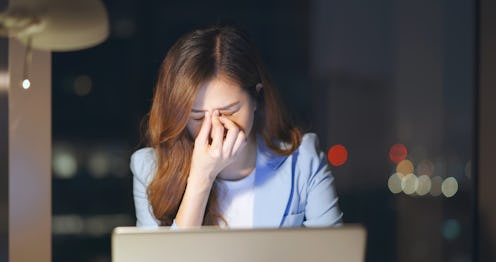
You and your colleagues had some good laughs during your last Zoom meeting, you’re on a roll with your work assignments, and even your spreadsheets aren’t that annoying. Your mind is focused and your body feels pretty good. But... now your eyes are dragging from staring at the computer for so long, and it’s putting a huge damper on your productivity. On days like this, treating eye fatigue is a prerequisite to staying awake and (at least somewhat) functional.
What Is Eye Fatigue?
The rest of your body doesn’t have to be tired for your eyes to be overwhelmed and exhausted, says Dr. Arunima Agarwal, M.D., a board-certified general pediatrician. And while folks typically associate eye fatigue with staring at Instagram — erm, spreadsheets — all day long, Agarwal says that any type of visual fixation can make your eyes drag.
“Tiredness of the eyes is caused by intensely focusing,” she explains. “For example, from driving long distances, long periods of detail work (like writing or sewing), reading, and now most commonly computer, cellphone, and screen time.” That intense focusing means you’re not blinking as often, neuro-ophthalmologist Dr. Howard Krauss M.D. previously told Bustle — and, according to The American Academy of Ophthalmology, digital screens can reduce your blink rate by a third to a half. And that leaves your pupils dry and often irritated.
In other words, when your eyes spend so long straining — whether you’re looking out at the road or over digital interfaces with little to no break — they’re going to need some rest.
But it’s not always easy to tell when your eyes are fatigued — sometimes, the symptoms can disguise themselves as other things. You might experience a headache, pain and stiffness in your upper body, and have trouble concentrating. But your eyes will likely feel it directly, too. They might get watery (or dry), your vision can get blurry, your eyes might burn or itch, and you may get extra sensitive to light. These are all signs that may indicate your body wants you to take some shut-eye time.
How Can You Prevent Eye Fatigue?
You might tease your parents for how big the print on their phone is, but Agarwal says that mom’s got the right idea. “Images and type on screens, like your computer or cellphone, are not as precise or sharply defined as words in a book or newspaper, the level of contrast of the letters compared to the background is reduced, and the presence of glare and reflections on the screen can also make viewing more difficult,” she tells Bustle. All that translates into even more eye strain.
The pain doesn’t have to be inevitable. If you don’t have the option to be on the computer less, you can still manage your screen time in a way that’s easier on your eyes. Even if you’re a millennial desperate not to feel old, Agarwal suggests increasing the text size on your screens. “Keep your screen about two feet away and make sure your eye gaze is slightly downwards,” she adds. Decrease your screen’s brightness and — this is an important one — don’t forget to blink frequently to lubricate your eyes. “You can even put a sticky note on your computer as a reminder,” Agarwal advises.
You also might want to set a recurring alarm on your phone for every 20 minutes for the sake of your eye health. “The 20-20-20 rule is a good start,” Dr. Agarwal says. “Every 20 minutes, look at an object at least 20 feet away, for at least 20 seconds.” That way, you’ll give your eyes a break before they start to panic at the overload.
How Can You Relieve Eye Fatigue?
If your eyes are already exhausted, try to start implementing some of the prevention techniques — and give yourself a complete break, too. “Definitely stop looking at any screen until you are feeling better,” Agarwal recommends. She also suggests making use of lubricating eye drops and warm compresses.
Agarwal says that it’s also important to get your vision checked by an eye doctor once a year. “Eye fatigue is not permanent, but can be worsened by underlying eye problems, and underlying eye problems like myopia can be worsened by digital eye fatigue,” she explains. “Making changes in your work environment will help, as will a regular eye exam.” Then maybe your eyes won’t be too tired to catch up on The L Word: Generation Q tonight after work.
Studies referenced:
Baird, P. (2020). Myopia. Nat Rev Dis Primers. https://pubmed.ncbi.nlm.nih.gov/33328468/
Sheppard, A. (2018). Digital eye strain: prevalence, measurement and amelioration. BMJ Open Opthalmology. https://www.ncbi.nlm.nih.gov/pmc/articles/PMC6020759/
Experts:
Dr. Arunima Agarwal, M.D., a board-certified general pediatrician
Dr. Howard Krauss M.D., neuro-ophthalmologist